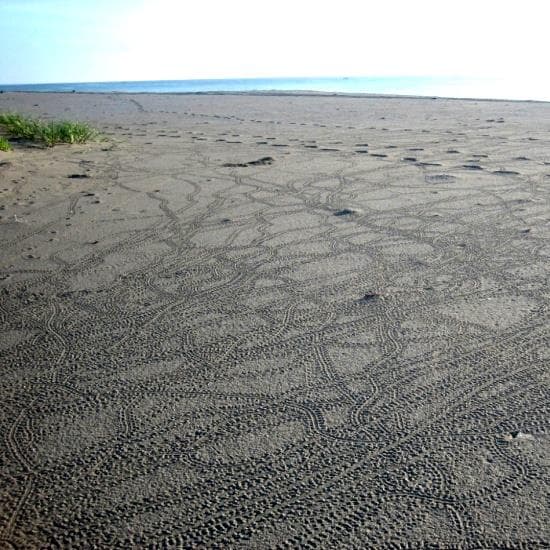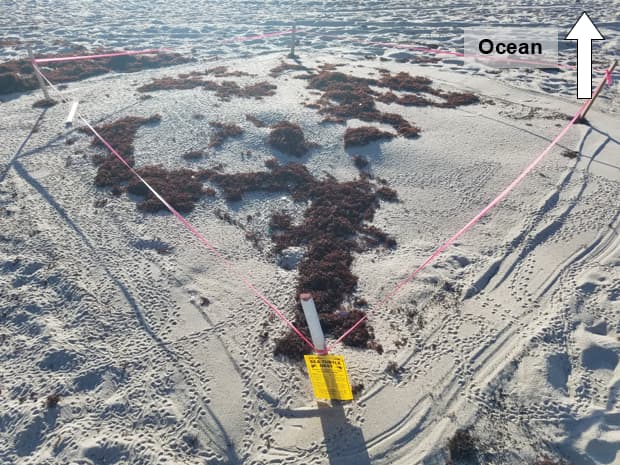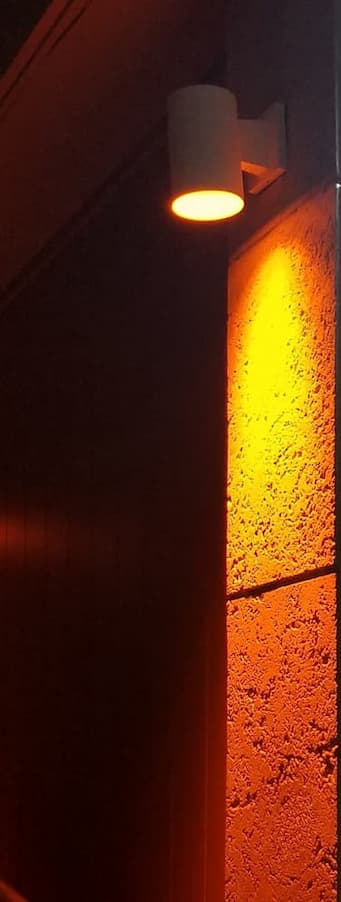Artificial Lighting and Nesting Females
Florida’s coastline has become increasingly developed over the past century, introducing a new threat to sea turtles. Artificial lighting emanates from the condominiums, hotels, businesses, and homes that are built on or adjacent to the beaches in southeast Florida. Nesting females emerge on beaches at night to find a suitable nesting location to lay their eggs, but artificial lighting on land may cause them to abandon their nesting attempt. Females waste valuable energy when abandoning their nesting attempts and could choose an unsuitable area to nest. Occasionally, nesting females become disoriented from artificial lights and wander around on the beach for long distances. In rare instances, female turtles have been found on properties adjacent to the beach and even in residential swimming pools and roads as a result of crawling towards artificial light.
Artificial Lighting and Hatchlings
Artificial lighting can also impact sea turtle hatchlings. Once they emerge from their nests, hatchlings instinctively move away from dark silhouettes and towards the brightest horizon. For millions of years, dunes and vegetation near land created dark shadows while the moon and stars reflected off the ocean surface which created a bright horizon. Today, the brightest horizon is often land due to the artificial lighting from businesses and homes that line the developed beach. As a result, newly hatched turtles frequently disorient and crawl the wrong direction on the beach, which wastes the energy they need to swim to the seaweed beds several miles offshore. Other threats of disorientation include dehydration, increased susceptibility to land predation, and fatal contact with automobiles.


Photos: Disoriented sea turtle hatchling tracks on the beach and from a hatched nest.
Credit: Sea Turtle Conservation League of Singer Island and Broward County staff.
Light Pollution
Light pollution can even be a problem for turtles if its origin is not directly on the beach. Light is often wasted into the sky from improperly directed fixtures, and this misdirected light can be seen from the beach as a “glow” on the landward horizon. This sky glow is another reason why female turtles abandon their nesting attempts and hatchlings disorient towards land. Sky glow can be challenging to manage since many inland cities may not have lighting ordinances and the source of light is likely many fixtures from multiple businesses or homes.
In order to combat excess artificial lighting along Broward County’s coastline, the County modified its Land Use Plan in 1997 to initiate the Broward County Beach Lighting Management Plan. Each coastal municipality within the County was required to enact and enforce a lighting ordinance requiring the extinguishing of beachfront lighting during sea turtle nesting season. The Broward County Sea Turtle Conservation Program (BCSTCP) conducts beach lighting surveys at night, from March through September, to document improperly lighted properties by street address. These surveys include type of fixture, approximate number of lights, and photo documentation of ordinance violations. All noncompliant lights visible from the beach are documented and surveys are provided to respective code enforcement officers each month.
Turtle-Friendly Lighting
Turtle-friendly lighting follows three criteria established by the Florida Fish and Wildlife Conservation Commission (FWC). Lights that are truly "turtle-friendly" meet all three criteria:
- Keep it low.
- Mount the fixture as low as possible and use the lowest wattage or lumen output necessary for the intended purpose.
- Keep it shielded.
- Use fixtures that meet or exceed full cutoff (do not emit light above a 90-degree plane) and that shield lamps or glowing lenses from being directly visible.
- Keep it long (wavelength).
- Long wavelength light sources are greater than 560 nm and include amber, orange, and red LEDs. The use of filters, gels, or lenses is not recommended.


Photos: A turtle-friendly shielded, amber light and an unshielded, white light that is not turtle-friendly. Credit: Broward County staff.
If you or someone you know resides on a beachfront property, there are several measures you can take to lessen the impact of artificial lighting on sea turtles:
- Turn off unnecessary lights that are visible from nesting beaches.
- If lights are deemed necessary for safety, use fixtures that are shielded so they cannot be seen from the beach.
- Apply window tint or install tinted glass on beach-facing windows.
- Close curtains or blinds at night.
- Use certified "turtle-friendly" lights that are shielded and amber or red in color; these lights are less disruptive to sea turtles. Visit FWC's website for more information about turtle-friendly fixtures and bulbs.
- Call local law enforcement or the BCSTCP Emergency Line at 954-328-0580 if disoriented sea turtle hatchlings are found away from the beach.
Artificial lighting is currently one of the most prominent threats to sea turtles in southeast Florida. In the future, light pollution could increasingly affect nesting sea turtles and hatchlings, unless a greater effort to correct problematic lighting is exerted by local communities. As the coastline of Florida continues to develop, it is important for everyone to follow the suggestions provided above in order to reduce human impact on the natural environment.
Lighting Support
Please contact 954-519-1255 if you have specific questions about your local lighting ordinance within the County or if you are seeking technical assistance for fixture or bulb retrofits.
